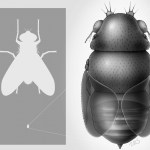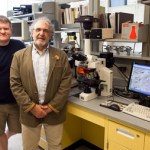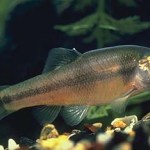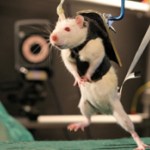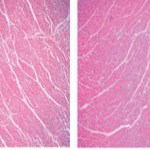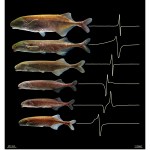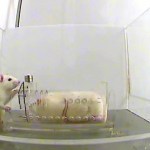
CREDIT: © Inna-Marie Strazhnik
Smaller than a grain of rice, the world's tiniest fly (Euryplatea nanaknihali, measuring only 0.4 mm) has been discovered in Thailand. According to the articles, these itty bitty bugs lay their eggs in the body of an ant where they develop and make their way to the head. They devour both the muscles that move the mouth of the ant as well as the brain eventually causing the head to fall off where they live and mature for another couple of weeks before emerging as adults.
Scientists have been able to keep rabbits alive for up to 15 minutes after their windpipes had been blocked by injecting microparticles (yellow in the image below) containing oxygen into their bloodstream. These microparticles are able to deliver the life-saving oxygen directly to red blood cells allowing the animals to survive with normal blood pressure and heart rates in the absence of the ability to inhale. Moreover, there was no evidence of heart, lung or liver damage from oxygen deprivation.
The problem with injecting oxygen bubbles has been …
The last known member of the subspecies Pinta Island tortoise (Chelonoidis nigra abingdoni), affectionately named Lonesome George, passed away on Sunday at about 100 years old (no one knew his exact age). He had been the last of his kind in the Galapagos Islands for the past 40 years, earning his nickname. The suspected cause of death is a heart attack. The Galapagos National Park Service will be preserving his body for future studies.
The reason for the extinction of these tortoises: overhunting by fishermen and sailors in the 19th century along with habitat destruction by feral…
In this video, Dr. Jaak Panksepp describes how he discovered that rats apparently laugh, producing an ultrasonic sound which more resembles chirping than laughter as we typically think of it:
Further research by Dr. Panksepp has shown that young rats tend to be more ticklish that older rats and that "laughter" ceases when the animals smell the odor of a cat or when they are hungry. As you might expect, his findings have been debated by other scientists.
To read a recent interview with Dr. Pankseep about rat "laughter" and his theories, click here.
Sources:
Scientific American
http://falk.…
Left: Derrik Hilton, an asistant in the laboratory of Dr. Charles Ide (right) at Western Michigan University. Image from: Katie Selden / Kalamazoo Gazette
Dr. Charles Ide from Western Michigan University has become a leader in the fight against Multiple symptom atrophy, or MSA, all because of frogs. His research on how contaminants in the Kalamazoo River impacts the health of frogs lead to the discovery that frogs injected with PCBs developed Parkinson's disease like symptoms.
Dr. Ide describes MSA (aka: atypical Parkinson's Disease) as being a trio of disorders making it…
Image from Scientific American
Great news for cougars: According to a recent study published in The Journal of Wildlife Management, cougars (Puma concolor) are beginning to repopulate the Midwest after an extended absence going back to the early 20th century. Their population declined in the Midwest when prey dwindled and they were being hunted to protect livestock and humans. Visit this website for a timeline of their decline across the Midwest. By the end of the 20th century, the animals were mainly restricted to the Western United States.…
Image from Wikipedia: "Adélie Penguins on the ice-foot at Cape Adare in the Antarctic. Photo taken in 1911 or 1912 by George Murray Levick, a member of Robert Scott's Terra Nova Expedition. Published in Scott's Last Expedition (1913). Dodd, Mead, and Company. New York. Volume II. Page 87. Also published in Levick, G. Murray (1914). Antarctic Penguins: a study of their social habits. New York: McBride Nast and Company."
According to the report on the Discover Magazine website, George Levick, a surgeon and zoologist, went on an Antarctic expedition with Captain Robert…
I was delighted to turn on my radio this morning and hear the interview with Dr. Barbara Natterson-Horowitz (UCLA) and journalist Kathryn Bowers about their book called "Zoobiquity: What animals can teach us about health and the science of healing" on the Diane Rehm show (NPR). This book describes many diseases that are shared between humans and certain animals. More information on shared diseases can be found on the website for the book.
You can listen to the interview here: http://thedianerehmshow.org/audio-player?nid=16187
Props to you Diane Rehm for…
Drs. Chia Soo and Bruno Péault, from the Eli and Edythe Broad Center of Regenerative Medicine and Stem Cell Research at UCLA, have found a way to turn stem cells from fat tissue into bone of higher quality than that grown with prior techniques.
The mesenchymal stem cells (MSCs) isolated from the fat tissue may develop into bone, cartilage, muscle as well as other tissues. More importantly, fat tissue is easily accessible through liposuction.
What is unique about their research is that they were able to purify stem cells from fat tissue relatively quickly. Until now, the…
I came across this relaxing video of comb jellyfish on Scientific American that I thought you would enjoy. I wonder if I could make this my screensaver...
Idiopathic autism has been on the rise in recent years and is thought to be caused by a mixture of genetic risk factors as well as some as yet unknown environmental factors. Research suggests a link between antidepressant use by pregnant women and the development of autism. Further, some unmetabolized psychoactive pharmaceuticals (UPPs) have made their way into drinking water from sources at the surface posing a potential environmental risk of exposure. To study the potential link between UPPs and autism, Drs. Michael Thomas and Rebecca Klaper exposed fathead minnows to a mixture…
Scientists have been able to restore locomotion in paralyzed rats using a combination of nerve stimulation and engaging the mind by having the rats complete simple tasks (like obtaining treats). In the newly published research, Dr. Grégroire Courtine (University of Zurich and the Swiss Federal Institute of Technology) and his team created a rat model of spinal cord injury. After designing a support jacket for the rats, they used a combination of neurotransmitters and electrical impulses to excite the nerves to produce involuntary stepping actions, which alone did not activate…
As a follow up to the blog on heart disease in chimpanzees, a reader asked if chimpanzees ever develop congestive heart failure. The answer is yes, this is a common cause of death in these animals. However, the pathology differs from humans. For humans, heart disease usually results from coronary artery atherosclerosis, which blocks the blood supply to the heart muscle resulting in reduced or diminished oxygen and nutrient delivery. In contrast, heart disease in chimpanzees is more commonly attributed to interstitial myocardial fibrosis whose origins are unknown. Moreover…
On a recent visit to The American Physiological Society's website, I found this amazing story on regeneration that I thought you might enjoy:
This summer’s action film, “The Amazing Spider-Man™,” is another match-up between the superhero and his nemesis the Lizard. Moviegoers and comic book fans alike will recall that the villain, AKA Dr. Curt Connors, was a surgeon who, after losing an arm, experimented with cell generation and reptilian DNA and was eventually able to grow back his missing limb. The latest issue of the journal Physiology contains a review article that looks at…
The 10 winning images from the inaugural Bio-Art competition hosted by the Federation of American Societies for Experimental Biology (FASEB) were announced last week. Here are my favorites:
Closely related species of electric fish with recordings of their electric organ discharge. This organ is used for communication and prey location, similar to echolocation used by bats. Note how the pattern differs between species. Submitted by Matthew E. Arnegard (Fred Hutchinson Cancer Research Center, Seattle, WA), Derrick J. Zwickl (University of Kansas, Lawrence) as well as Ying Lu…
Photo: Science/AAAS
I find myself wondering why a rat would choose to liberate a cagemate when they have the opportunity to enjoy a goldmine of chocolates if they would just leave the other rat locked up. Dr. Peggy Mason, a neuroscientist, and psychologists Inbal Ben-Ami Bartal and Jean Decety conducted a study in which they placed pairs of rats in pens with one free to run about and the other placed in a restrainer in the middle. They found that 23 out of 30 rats freed their cagemate but did not bother to open empty restrainers or those containing stuffed rats. In another…
Image: Researcher Hans Roy opening a core sample, photo by Bo Barker Jørgensen, © Science / AAAS
I was amazed to find out that there are bacteria in the ocean floor that have metabolisms roughly 10,000 times slower than those living at the surface of the seabed. This extremely slow lifestyle may allow them to live very long lives. In fact, these microbes were found in a core sample of clay collected up to 20 meters beneath the seafloor of the North Pacific Gyre, just north of Hawaii. This depth means that the microbes settled on the ocean floor about 86 million years ago! While these as…
Image: Jill Moyse (left) and Maureen Leahy (right) monitoring Keo, a 54-year-old chimpanzee in the Lincoln Park Zoo. (AP Photo/M. Spencer Green)
Dr. Kathryn Gamble, the chief veterinarian at the Lincoln Park Zoo in Chicago, has been studying heart disease in captive chimpanzees. Over one third of deaths in these animals are related to heart disease despite healthy diets, exercise and regular testing. Her team has implanted heart monitors in eight of the captive animals in an effort to help fight heart disease in apes, three of which have been trained to present their chests to a scanner to…
Fish respond to fear by secreting chemicals (pheromones) designed to warn other fish of danger. To date, some of the components of this so called "Schreckstoff" (meaning fear stuff) have been identified. These include hypoxanthine-3-N-oxide (H3NO), polysaccharides, oligosaccharides, and glycosaminoglycans (GAGs). Researchers in Singapore have now identified chondroitin sulfate, a complex sugar molecule, as one of the active ingredients in Schreckstoff.
Sources:
-Reuters
-Stensmyr MC, Maderspacher F. Pheromones: Fish Fear Factor. Current Biology Vol 22 (6): R184-R186, 2012.
New research at Emory University may be able to provide that information. Researchers Andrew Brooks, Gregory Berns, and Mark Spivak have been studying the brains of dogs using functional magnetic resonance imaging (fMRIs). What is unique about this work is they have been able to train two dogs, Callie and McKenzie, to enter a fMRI machine and sit still, eliminating the need for anesthesia. Through this mechanism, they hope to study the activity in their brains as the animals hear commands or see stimuli in an effort to unravel what they are really thinking.
